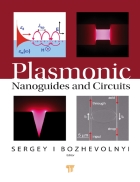




Mã tài liệu: 202587
Số trang: 450
Định dạng: pdf
Dung lượng file:
Chuyên mục: Khoa học công nghệ
Modern communication systems dealing with vast amounts of data at ever increasing speed started to progressively stronger experience the fundamental limitations imposed on the existing electronic and optical technologies. Speci_cally, nm-sized electronic (metallic) circuits are inherently slow due to RC-delay times, whereas optical (dielectric) circuits having enormous information capacities are essentially _m-sized due to di_raction e_ects. It is fascinating to note that electromagnetic modes supported by metaldielectric interfaces were found to be beating the di_raction limit while upholding the optical bandwidth. These modes, in which optical _elds are coupled to electron oscillations, are usually called surface plasmons (SPs) and are characterized by the wavelength that is always shorter than the wavelength in the dielectric, exhibiting thereby subwavelength connement.
It should be emphasized that not all SP modes allow for unlimited squeezing in the cross section perpendicular to their propagation (i.e., going \nano"), a property that is imperative for realization of plasmonic circuits combining the compactness of electronics with huge bandwidth of optical networks. In this book, we concentrate on SP guiding geometries ensuring truly nanoscale _eld con_nement and review the current status of this very young but rapidly growing area of nanoplasmonics. Both fundamental physics and application aspects are overviewed in detail by world-leading experts highlighting the most signi_cant achievements and reporting on the latest advances within nanoscale plasmonic guides and circuits. SP modes that persist to exist in the limit of in_nitely small waveguide cross sections (being correspondingly squeezed to progressively smaller transverse dimensions) are introduced in Chapters 1 and 2. The two chapters provide the main dispersion relations as well as explain the underlying physics of guiding beyond the di_raction limit. The chapters that follow are self-contained and they consider particular SP guiding con_gurations summing up previous developments and outlining future research directions. SP excitations supported by chains of nanoparticles are analyzed and experimentally investigated in Chapter 3. Chapters 4 through 8 consider the di_erent aspects of SP guiding between two metal surfaces, with recent experiments on all-optical plasmonic modulators being presented in Chapter 7. Propagation of SP modes along metal grooves (channels) and wedges is analyzed in Chapters 9 and 10, followed by the experimental demonstration of nanophotonic components utilizing channel SP modes in Chapter 11. Adiabatic concentration of the optical energy and coherent control of SP propagation in tapered nanoplasmonic waveguides are treated in Chapter 12. Finally Chapter 13 reviews some of the key developments in the rapidly emerging _eld of nanoplasmonics as well as discusses challenges that need to be addressed before the dream of integrating plasmonic, electronic and optical components can be realized. It has been a great pleasure to work with some of the leading scientists in nanoplasmonics during the preparation of this book. I am deeply grateful to all contributing authors for their eorts and enthusiasm in sharing the very latest results in this excitingeld. I would also like to acknowledge Elena Bozhevolnaya for taking care of technical issues associated with actual collection and administration of the book chapters.
Những tài liệu gần giống với tài liệu bạn đang xem
📎 Số trang: 693
👁 Lượt xem: 398
⬇ Lượt tải: 16
📎 Số trang: 629
👁 Lượt xem: 405
⬇ Lượt tải: 16
📎 Số trang: 226
👁 Lượt xem: 295
⬇ Lượt tải: 16
📎 Số trang: 652
👁 Lượt xem: 353
⬇ Lượt tải: 16
Những tài liệu bạn đã xem
 Plasmonic Nanoguides and Circuits
Modern communication systems dealing with vast amounts of data at ever increasing speed started to progressively stronger experience the fundamental limitations imposed on the existing electronic and optical technologies. Speci_cally, nm-sized
pdf Đăng bởi
henrycuong279
Plasmonic Nanoguides and Circuits
Modern communication systems dealing with vast amounts of data at ever increasing speed started to progressively stronger experience the fundamental limitations imposed on the existing electronic and optical technologies. Speci_cally, nm-sized
pdf Đăng bởi
henrycuong279